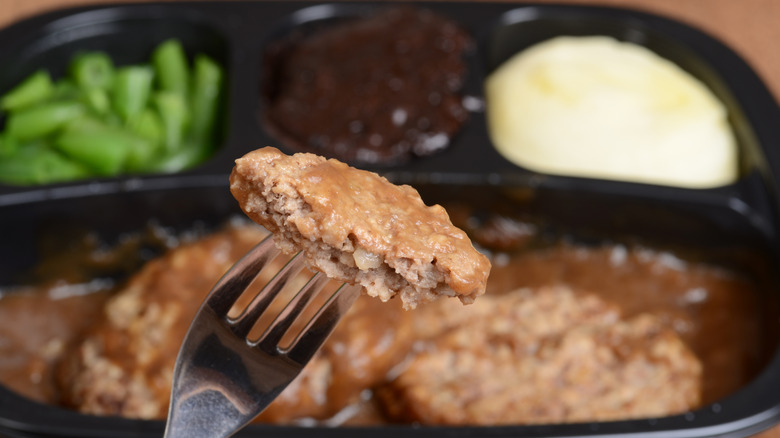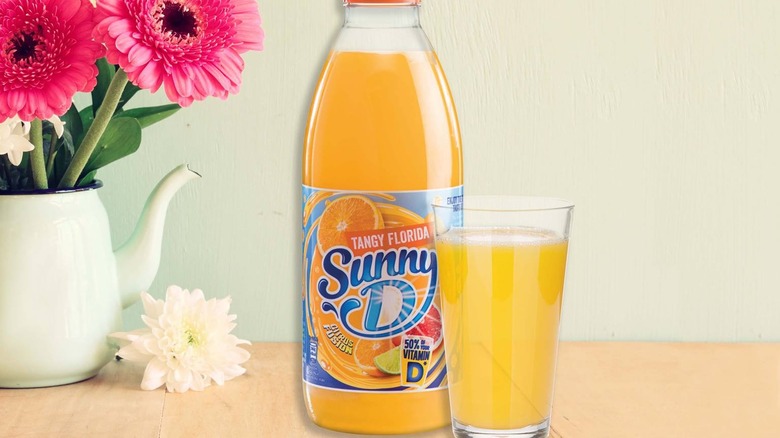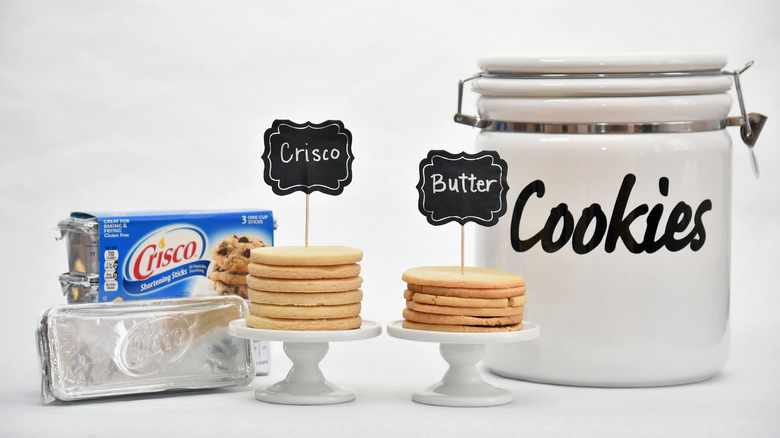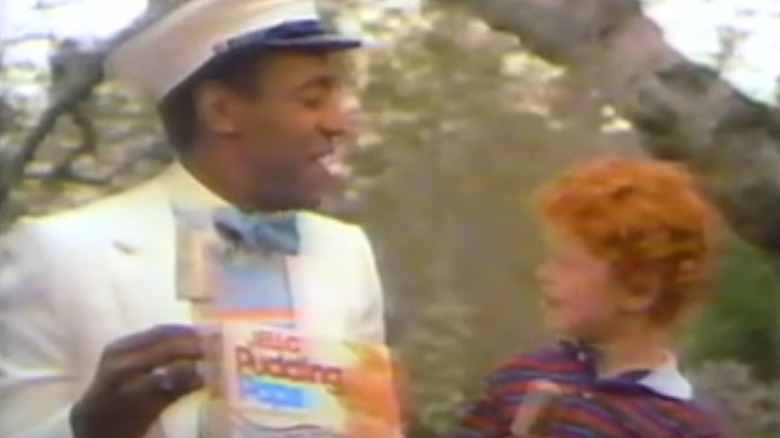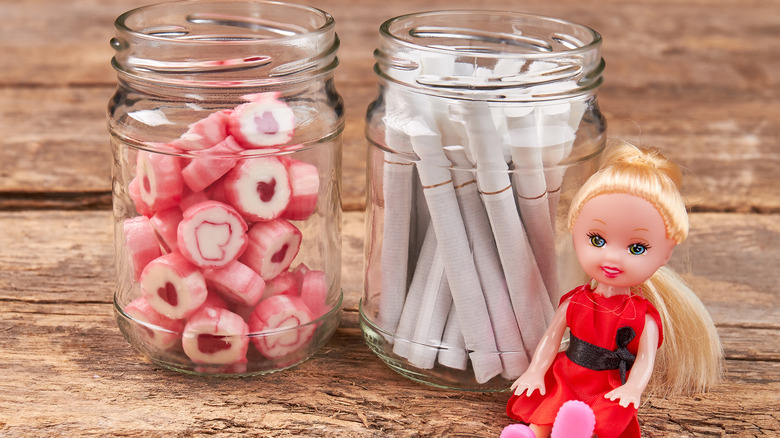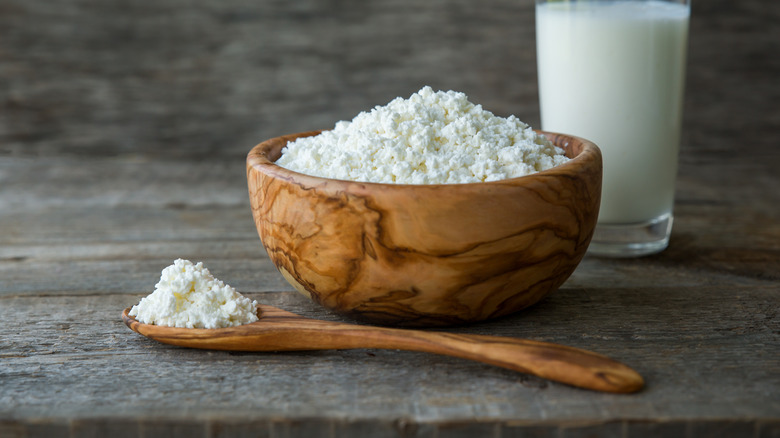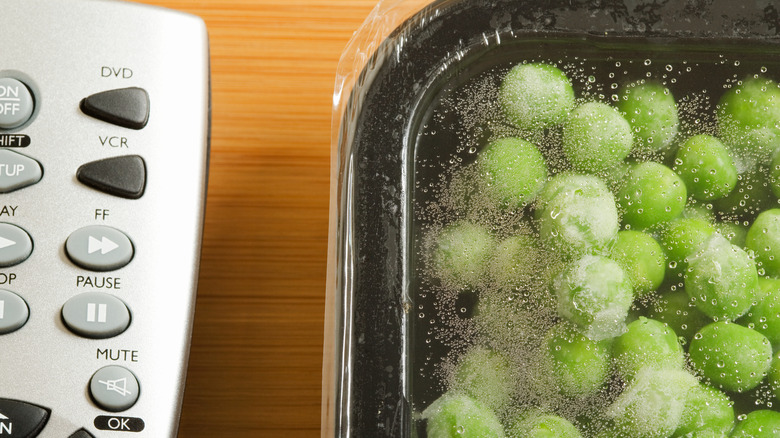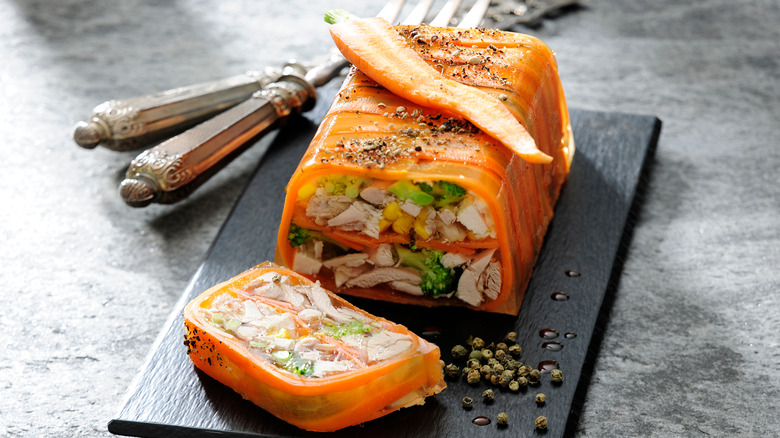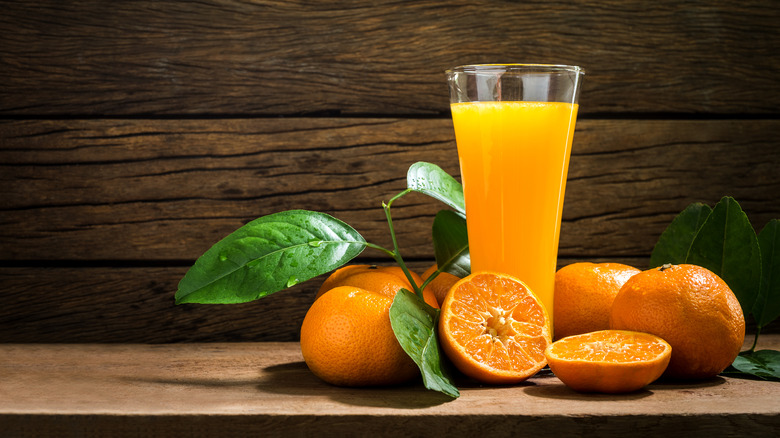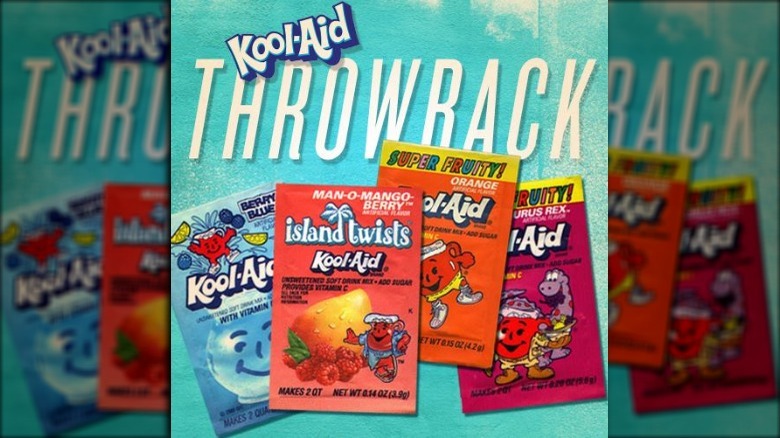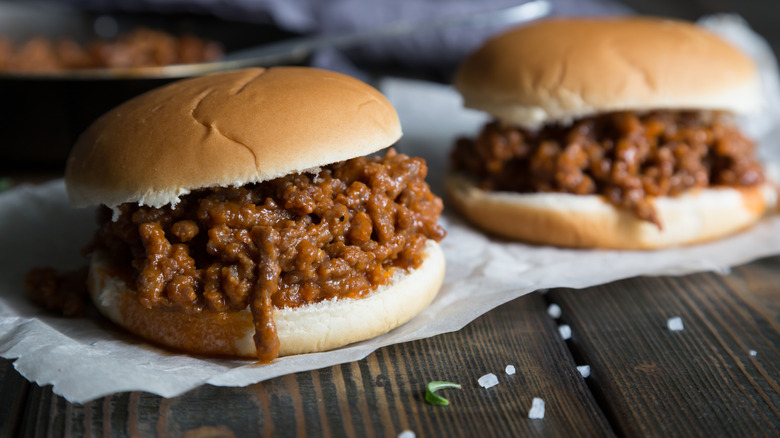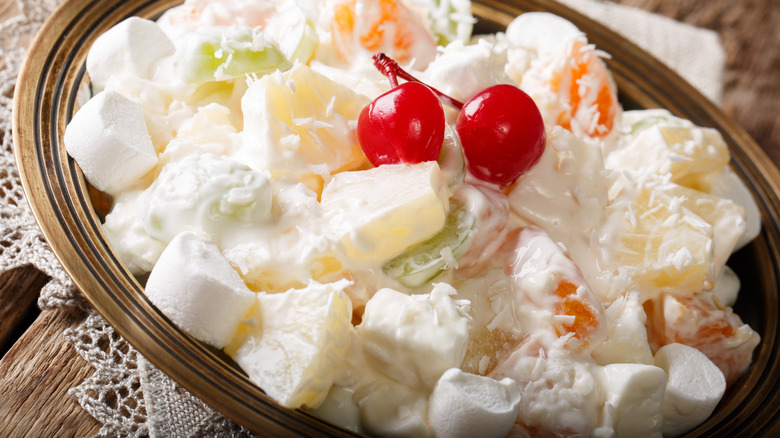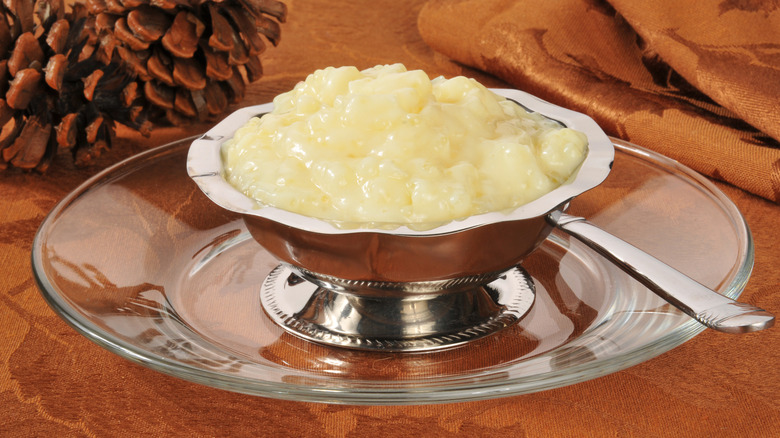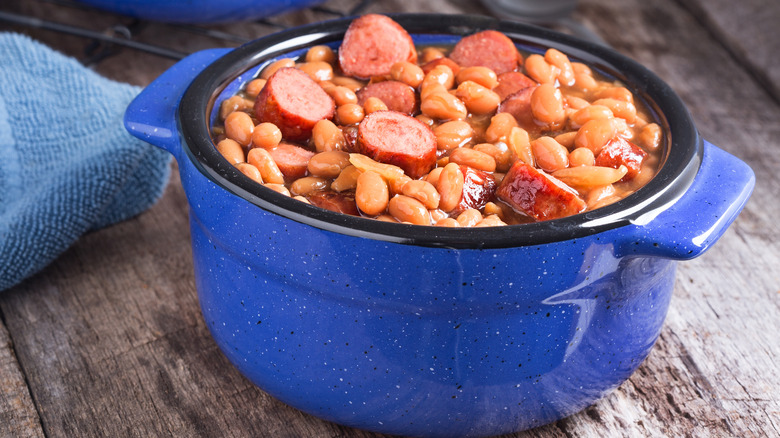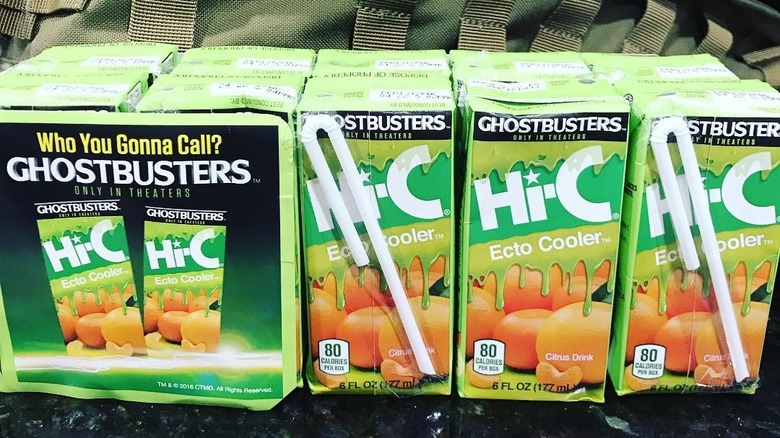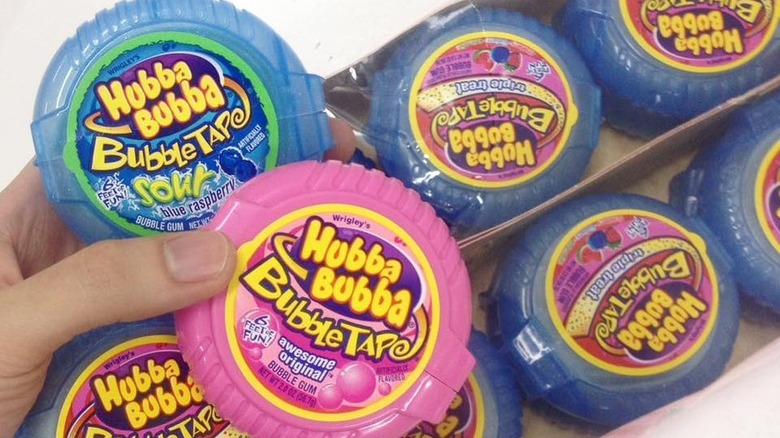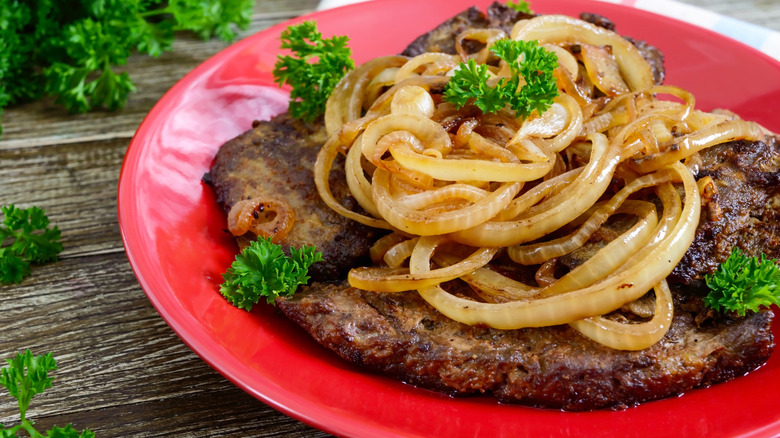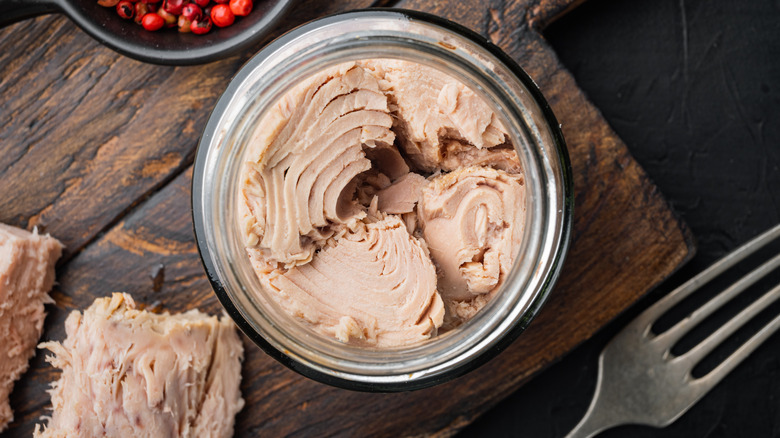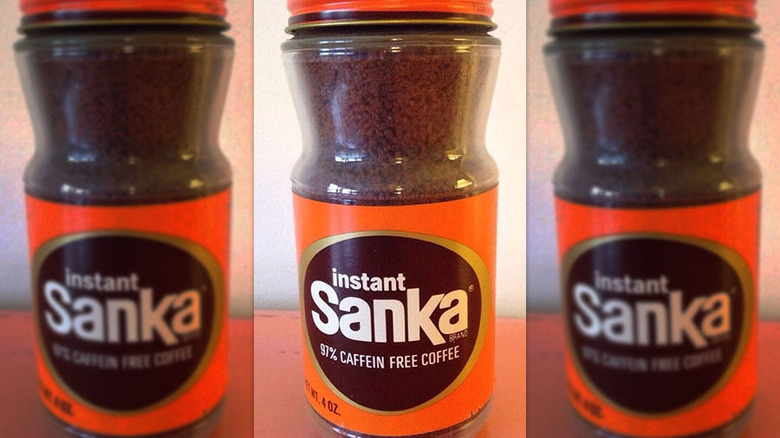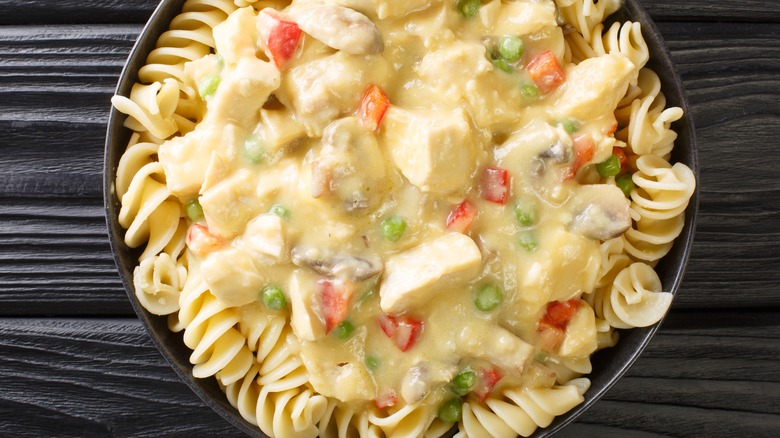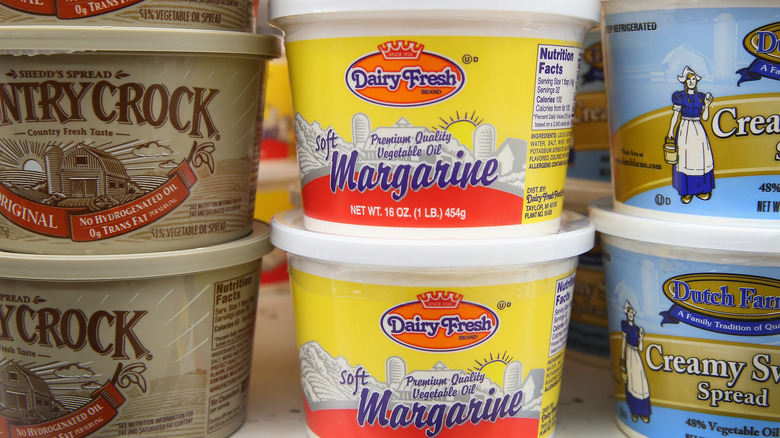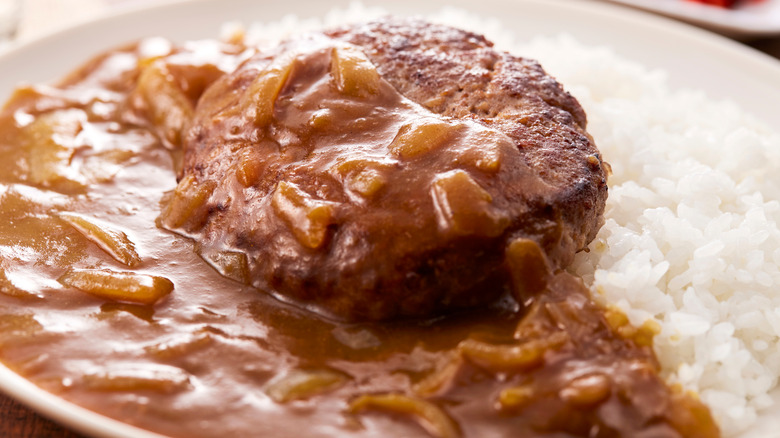21 Once-Popular Foods That We All Stopped Eating
We've all suffered from a bit of nostalgia at some point, a sort of sad longing for days gone by. If that sounds familiar, you should count yourself lucky it's the 21st century. Just a few hundred years ago, says The Atlantic, nostalgia was considered a mental illness "treated" by everything from shaming to being buried alive.
One of the things thought to cause nostalgia was eating strange, unfamiliar food, and it makes sense. There's a reason that familiar staples are called comfort food, after all, and food connects us to not just others, but to our past, and especially to our childhoods. Tastes and smells can be a powerful thing, and some foods bring back memories of holidays with the family, of birthday celebrations, and hot summer days that seemed to last forever.
So, let's take a walk down memory lane and experience some nostalgia — here's some once-popular foods that have just sort of... disappeared.
1. Sunny Delight
Remember Sunny D? That ridiculously orange drink that kids clambered for throughout the '80s and '90s? What happened to that stuff, anyway?
The Tab says Sunny Delight hit shelves in 1968, well before we were really paying attention things like artificial ingredients. It was almost insanely popular, and when it hit the UK in 1998 it came in behind only Coke and Pepsi in the drinks market. That's weird, because it was essentially 4 to 5 percent fruit juice and 95 percent a watery, super-runny corn syrup.
Yum. Sunny D's downfall came due to a combination of a few things. The Food Commission, an independent consumer commission in the UK, started to call out manufacturer Procter & Gamble for their misleading advertising that suggested there was some sort of nutritional value to the stuff, when there definitely wasn't. And in 1999, a 5-year-old Welsh girl really did turn a yellowish-orange color after drinking way, way too much of it. That story passed into urban legend territory (but it's completely true), and Sunny D overhauled their recipe and rebranded in an attempt to shake their super unhealthy image. It's still on shelves, but it never really got popular again.
2. Crisco
There was a time when every kitchen had a big tin of Crisco kicking around somewhere. It's what made all those homemade chocolate chip cookies taste so amazing, but unfortunately, we know now that it's horrible for you. It was just partially hydrogenated vegetable oil processed into a solid, which means it was pretty much a bucket of trans fat.
Crisco has changed their recipe since then, says NPR, but it hasn't reclaimed a place in our kitchens. Part of the reason for the fall of Crisco is likely the massive shift in how it's been portrayed. NPR says it was first marketed as a super-healthy alternative to lard, and even through the 1980s it — and other trans fats — were promoted as much healthier than saturated fats.
All that changed in the 1990s, when we started to realize just how bad trans fats are. Even though the Crisco of today isn't the same as the Crisco of the '80s, it's hard to recover from the devastating findings that your "healthy" wonder-food is slowly clogging your customers' arteries.
3. Pudding Pops
Pudding Pops were pretty much the perfect treat for those hazy, lazy days of summer vacation. You can't find them today, though, so... what happened?
Surprisingly, the disappearance of these doesn't have anything to do with the meteoric downfall of the once-beloved celebrity spokesperson who made them famous: Bill Cosby. Culinary Lore credits Cosby and Jell-O's 1980s marketing campaign for their huge popularity, and in the first year they logged $100 million in sales. That tripled in the first five years, but the company quickly realized that big sales don't necessarily translate into big profits.
The problem was that Jell-O didn't have much experience in the frozen foods business. Producing and distributing a frozen product like Pudding Pops added a ton of overhead that the company could have avoided by sticking to dry products like Jell-O packets. With profit margins tight, Jell-O discontinued the product in the early '90s, before licensing the rights to Popsicle in 2004. After that, they became Popsicle-branded Jell-O pudding pops, with an entirely new recipe and a different shape that people just weren't as fond of. Eventually, the new version was also discontinued and Jell-O Pudding Pops vanished from our shelves for good."
4. Candy cigarettes
Given what we know now about the dangers of smoking, it's pretty shocking it wasn't that long ago candy cigarettes were marketed to kids — complete with knock-off packaging that advertised "brands" like "Kamel" and "Winstun." It wasn't just an adorable gimmick, either. Mother Jones reports that a 2007 survey done of 25,000 people found those who "smoked" candy cigarettes as kids were about twice as likely to become adult smokers.
The first candy cigarettes were actually chocolate, and they were made by Hershey at the turn of the century. The chalky, more realistic-looking ones came in the 1920s, and they were actually banned by one state — North Dakota — between 1953 and 1967.
They were still pretty popular, though, as manufacturers advertised they could make you "Just Like Daddy." They were never actually outlawed — Big Tobacco blocked legislation that would have taken away what was essentially free advertising — but after the truth about smoking came out in the 1980s, parents were suddenly less keen to encourage their kids to pick up a deadly habit. You can still get them, technically, but they're called "candy sticks."
5. Cottage cheese
Cottage cheese has a long history, as it dates back to a Colonial era when nothing went to waste — not even the leftover milk that was scraped off the cream. It's been pretty consistently produced, but it wasn't until the 1950s that it became super trendy. It was popular for decades, so popular in the 1960s that it was mentioned in Mad Men, and it peaked in the 1970s, says NPR's The Salt. Americans averaged about five pounds a year, it was a common ingredient in other recipes, says the Independent, and more importantly it was eaten alone by the more health-conscious of diners.
Somewhere along the line, though, people became less enamored with cottage cheese's weird texture and bland taste. Part of the problem is likely that it's hard to make a cottage cheese that's consistent, but yogurt? That's much easier to make, much more of a consistent product, and manufacturers have developed so many flavors and types that everyone's bound to find something they like. Not surprisingly, the more old-fashioned cottage cheese got kicked to the curb.
6. TV dinners
While not many people are reaching in the freezer to pull out a TV dinner these days, they changed the way we eat. They were first developed in the 1950s, and according to The Atlantic, they were created by Swanson as a way to package and sell Thanksgiving leftovers. There's another part of the story, too — the BBC notes they were the brainchild of bacteriologist Betty Cronin, who was inspired by the search for a way to keep business high after the need for supplying wartime rations to the troops ended.
They ultimately kick-started our love for everything pre-wrapped, already prepped, and simplified, but then a weird thing happened. Swanson sold 25 million meals the first year their TV dinners hit the shelves, and sales steadily climbed until 2008. That's when sales dropped with such startling speed that Nestle was ready to unload their frozen food division, valued at around $400 million. Since then, sales have continued to drop or remain flat, and with more and more people valuing freshness over convenience, it seems as though the day of the TV dinner has passed.
7. Congealed salads
Congealed salads — which are basically everything and anything from fruit and vegetables to fish and meats encased in jiggly Jell-O — were popular for a long, long time. The basic idea has been around since medieval Europe, when it wasn't Jell-O, but gelatin made from calf feet.
Serious Eats says there are a few reasons they were popular. They were a practical way to use leftovers, they were versatile, easy, and mess-free, and by the time World War II rolled around, they were a bit of deliciousness in the face of rationing. (The Daily Meal adds they were also a bit of a status symbol, because if you could afford the refrigerator you needed to make it, you were doing pretty well.) They stayed so popular that by the 1960s, Jell-O released savory flavors (like mixed vegetable and celery), but once we moved into the 1970s, congealed salads started heading out.
Part of it was convenience — they're actually pretty time-consuming to make — and part of the reason was because even then, we were trying to cut back on sugar. You can still find people making Jell-O salads, as they've managed to stay in vogue, particularly in Utah. For the rest of the country... not so much.
8. Orange juice
For decades, fruit juice was an important part of almost everyone's breakfast. In recent years, however, breakfast had changed. In 2014, Quartz reported orange juice sales were particularly hard-hit, sinking about 40 percent over the previous 15 years. Three years later, they were reporting the trend was continuing in America and in Europe.
That's a huge difference from the previous decades. For around 50 years orange juice was present at most breakfast tables — at it's peak, an average of 75 percent of American households had orange juice in the fridge all the time. The drink's heyday started after World War II, when scientists finally discovered how to process it and get it to your table while making sure it still tasted like oranges. But in the late 1990s, price increases due to insect blight, a decline in the number of people who eat breakfast, and an increased awareness of just how much sugar is in orange juice, started a steady decline.
That's presenting some serious problems for Brazil, who produces most of the world's oranges. The decline is so bad that they're looking elsewhere for what they can do to fill the void, and that speaks volumes as to just how out of love we've fallen with this one-time favorite.
9. Kool-Aid
Remember making Kool-Aid on a hot summer day? It was so easy, even the youngest kids could do it. Just dump a ton of sugar into some water, add the packet, and done!
It is any wonder we've kind of gotten away from this super-sugary, artificially-colored drink?
There was something else that caused the fall of Kool-Aid, too, and it has nothing to do with sweetness. In 1978, Jim Jones and his followers were front and center in one of the most horrific cult massacres of the century. According to The Atlantic, more 900 people died after drinking a toxic mixture Jones gave them. It was poison, and it was also grape Flavor Aid.
No, it wasn't Kool-Aid, but the tragedy gave rise to the saying, "Don't drink the Kool-Aid," which is basically a warning not to blindly follow leaders that are anywhere from misguided to maniacal. Forbes says the association — even though it's completely wrong — between the Jonestown massacre and Kool-Aid did some serious damage to Kool-Aid's reputation, and it's one of the heartbreaking reasons you probably don't keep this in your cupboard any more.
10. Sloppy joes
If you completely forgot this childhood favorite even existed, you're not alone. Sure, you can still find them occasionally and there's even at least one gourmet sloppy joe food truck out there, but they're nowhere near the weekly dinnertime staple they once were.
Eat A Sandwich took to social media to try to find out just when was the last time someone had a sloppy joe, and answers varied but hovered around, "Some time in the 1990s." No one really knows why they fell off our dinnertime radar, especially considering that many people that were asked remembered them as tasting pretty good.
There were a ton of theories, though, and many are legit. It's possible it's a health thing, and they're just too high in sodium for people. The name might be turning people off as adults, and they haven't been targeted with the same kind of makeover foods like grilled cheese have. One response was the simple, straightforward, "Because we're not 11."
11. Ambrosia salad
Think back to almost every backyard BBQ, cookout, and family reunion you went to as a kid... there were at least a few dishes of ambrosia salad, weren't there? There are a ton of ways to make them, but most involve Jell-O, whipped cream or Cool Whip, cream cheese, and chunky bits from pineapple and oranges to coconut and pecans.
Sounds... interesting? Serious Eats says ambrosia salad dates back at least to the late 1800s, and adds that it likely became popular because at the time, all those ingredients were special, exotic treats. It became linked with Christmas traditions, and it just sort of stuck around in the South.
While there's a small portion of the population — again, mostly in the American south — that is trying to give ambrosia salad a makeover and re-popularize it, NPR found many people are just happy this weird stuff is going the way of the dodo.
12. Tapioca pudding
There's a good chance you forgot that tapioca pudding is even a thing, right? The pre-made stuff comes in a tub-like container from the refrigerated section of the grocery store, and it regularly gets passed over these days in favor of more popular snacks like Greek yogurt. You can even find it on the shelf with the individual packs of Jell-O and pudding, but it's usually on the top shelf collecting dust. And even that packaged stuff doesn't hold a candle to the homemade kind that Grandma used to make — so, what happened?
It's not entirely clear, but culinary historians and genealogists over at Aunt Lil's Kitchen have recreated some of the recipes from the era before pre-packaged convenience food, and suggest scratch-made tapioca fell from popularity because it was a time-consuming and rather difficult process. We may have made it easier by just opening a package, but with that, we've given up delicious, comforting, homemade goodness. It's just not the same.
According to one writer for The New York Times Magazine, it probably fell out favor for two reasons: most chefs' inabilities to cook it to proper consistency, and the disgusting associations made with it when it's tasted at an improper consistency. Unfortunately, improper cooking was all too common, which is why the pudding earned the nickname "fish eye pudding." With a nickname like that, it's no wonder people stopped eating it!
13. Franks and beans
It wasn't long ago that no one had a backyard cookout without a massive tray of franks and beans. People took it seriously, too — New England Nostalgia in New England Living Today had one writer reminiscing about how important it was to get the beans just right, calling it "the secret of not only a great supper, but of a marriage as well."
Click Americana looked back at some recipes from the 1960s, and they weren't just for casseroles, they were for sandwiches, too. Franks and beans were easy, affordable, filling, and delicious... so why aren't they a mealtime staple anymore?
There might be a few reasons, and one is just that there are so many other ways to eat hot dogs. Food Republic put together a chart of all the different ways people eat hot dogs, and franks and beans can't hold a candle to some of them — like Memphis's bacon-wrapped dog. In fact, it didn't even make the list — that should tell you a lot about how little this dish is even thought about these days.
We're also a little more aware of the consequences of sodium these days, and the University of Wyoming notes that canned beans and hot dogs are both pretty high in sodium. Maybe it's the health-conscious crowd that's taken this tasty staple away?
14. Hi-C
The ever-popular, ever-coveted Ecto Cooler was finally discontinued in 2001 after an impressively long run (aside from a brief reappearance for the Ghostbuster reboot). But as much as we all miss the Ecto Cooler, we're still not buying many of the juice boxes Hi-C carries.
Business Wire says sales of kids' beverages have been on the decline since at least 2008, and there are a few reasons for that. Healthy Children warns parents about the sugar content in kids' drinks, and one little box of Hi-C Wild Cherry contains 27 grams of sugar. (That's more than the American Heart Association recommends for an adult woman have in a whole day!) And Romper points out they're not exactly environmentally friendly, either. A juice box can take 300 years — at least — to disintegrate, and anyone who wants to set a good example for their kids is opting for reusable containers.
McDonald's had a hand in forcing us all to stop drinking Hi-C, too — more accurately called Hi-C Orange Lavaburst — when they decided to stop carrying it in 2017. Business Insider says social media was outraged, but adds that McDonald's doesn't care what you think
15. Bubble Tape
You still probably remember some of the most popular bubble gums you traded with your friends (and had taken away quite a few times), even if you've outgrown them.
Like Bubble Tape. Who's going to whip out a roll of Bubble Tape at the office? You totally should and could, though, because you can still buy it under the name Hubba Bubba Bubble Tape.
Even more surprising is the fact that Fruit Stripe gum is still around, too. It's not easy to find, but if you're in the mood for a bit of gum that's full of the same short-lived flavor you remember but still love, it's out there. So is Bubble Yum, the super-sweet, super-fruity gum that suffered briefly from the strange rumor it was made with spiders' legs and eggs. (Snopes confirms it's not true, if you needed clarification.)
It's understandable (but sad) that we don't enjoy these fun gums anymore now that we're adulting, but even the kids aren't chewing these gums much. What happened here? It's likely these '80s and '90s favorites were pushed aside when we realized sugar-free gum wasn't terrible, and that we could chomp away without giving ourselves a side of tooth decay.
16. Offal
When we talk about offal, we're talking about some of the dishes your grandparents and great-grandparents probably survived on. Those are things like liver and onions, steak and kidney pie, tripe, and sometimes even brains. We don't really need to say why these fell out of fashion, right? They're absolutely not in line with almost anything in today's palate, and the idea of eating kidneys is just, well, gross.
But offal was a staple during times when nothing went to waste, and was popular more recently than you might expect. According to The Atlantic, there was a huge push during World War II to make eating offal standard American fare. Times were tight, meat was rationed, and a huge amount was going overseas to feed Allied troops. On the home front, the government recruited the help of social psychologists to help make offal more appealing to the masses — and it worked. Kind of. That's probably why your grandparents stirred kidneys into stews, but it's also likely that once we had abundant access to things like hamburgers and steak, we quickly abandoned the inner icky bits.
17. Canned tuna
A pantry staple for generations and a true marvel in the history of food preservation and distribution, tuna caught, tightly packed in stout round cans in water and oil, and then shipped around the world is a versatile and relatively inexpensive source of lean protein, used most often in 20th century homemade and informal dining classics like tuna noodle casserole, creamed tuna on toast, and the tuna salad sandwich.
Industry leaders StarKist, Bumble Bee, and Chicken of the Sea became household names with over a century of business, but by the 2010s, according to The Wall Street Journal, canned tuna was rapidly swimming away from the American culinary mainstream. Between 1986 and 2016, per capita tuna consumption in the U.S. declined by half. According to StarKist's consumer research, the food's perceived lack of convenience is to blame. When presented with countless other food options, the idea of opening and draining a can, then needing dishes and utensils to prepare it (if not other foods to mix or add in). "A lot of millennials don't even own can openers," StarKist's marketing and innovation VP Andy Mecs said. Fish sales remain robust — millennials buy a lot of frozen and fresh seafood, more readily available today than in decades past.
18. Sanka
Millions start the day with coffee, and the market for caffeinated beverages has exploded over the past few decades. Coffee drinkers have benefitted from industry players trying to top each other with premium blends and preparations, with Starbucks, Dunkin, McDonald's, and other fast food coffee purveyors offering up carefully roasted blends and varieties more flavorful than what previous generations by and large had to make do with: a big tin can of pre-ground coffee made by the likes of Folgers or Maxwell House.
The appeal of Sanka was that it offered both convenience and a lower caffeine option. Coffee fans could prepare a cup of Sanka — freeze-dried coffee crystals that when rehydrated with hot water, approximated a serving of coffee — but with the powerful stimulant of the caffeine removed. Introduced in the early 1900s, according to The New York Times, Sanka became so well-known and frequently consumed that the product name became interchangeable with all decaffeinated coffee. ("Sanka" is derived from a French word for "without caffeine.") General Foods won the rights to market the product in the U.S. in the mid-20th century and aggressively advertised on early television. When Kraft bought out General Foods in the mid-'90s, it stopped actively shilling Sanka as much and made it a sub-brand of Maxwell House (via BrandandUSA). Today, it's still available, but as a hard-to-find specialty item.
19. Chicken a la king
It was essentially a casserole like so many other creamy, meaty, concoctions popular with home cooks and big families for the better part of the 20th century, but chicken à la king was just a little different. The dish was perceived as a bit fancier than the usual hot dish likely due to the name, implied to be so special that it was fit for royalty. Originally consisting of diced chicken, peppers, and mushrooms in a cream sauce and served on toast, according to Politico, the origins of chicken à la king are disputed. It was likely invented around 1900 and named after E. Clark King II, who ran New York's Brighton Beach Hotel. It became a signature dish of the haunts of New York's upper crust and by the 1960s, per the New York Public Library's menu archives, it had been served at upwards of 300 eateries, often atop rice or noodles instead of toast.
Over time, chicken à la king became an inexpensive food for middle-class families, and was served at countless wedding receptions, gatherings, and in school cafeterias. It was so entrenched in American cuisine that Stouffer's churned out a frozen dinner version in the late 20th century. Today, that Stouffer's entree is hard to find, as is chicken à la king on many restaurant menus. It seems to be now more associated with a bygone era in which highly caloric casseroles were commonplace.
20. Margarine
According to the Encyclopedia of Food Sciences and Nutrition (via ScienceDirect), the first inexpensive butter alternative came out of France in 1869, made out of churned milk and beef tallow. In the early 1900s, the development of hydrogenation — a process that turns liquid oils into soft solids — made modern margarine possible. Various vegetable oils at an industrial level were far cheaper than butter, allowing food manufacturers to mass produce a product that looked, tasted, and melted like the real thing, but at a fraction of the cost.
By the late 1960s, margarine sales in the U.S. and Europe nearly equaled that of butter, with consumption driven by conventional wisdom in the 20th century which held that plant-based kinds of margarine were healthier than butter. Margarine companies delivered on that public need by rolling out scientifically concocted fake butters with less fat than ever, processed from different oils and oil combinations.
But as thinking changes, so do tastes. According to Quartz, consumers in the U.S. came to see butter and margarine as interchangeable, roughly equal in terms of total fat, and products that shouldn't be over-consumed. Since butter tasted better than the thing that aimed to imitate butter, grocery buyers re-embraced butter. Since 2000, margarine sales have dropped by 32% and butter sales have risen by 83%.
21. Salisbury steak
Consisting of minced beef arranged into a patty and then slathered in a salty, brown mushroom gravy, Salisbury steak is an inexpensive downmarket imitation of pricier and fancier steaks. It's essentially a hamburger without the bun and with sauce, and dates to a period in food history before such convenient, tasty, crowd-pleasing sandwiches were ultra-ubiquitous.
According to Smithsonian Magazine, Dr. James Henry Salisbury, who developed the food in the 19th century and served as its namesake, called it "muscle pulp of beef," and he developed his steak over 30 years of study into the curative powers of food, believing he could cure intestinal issues, diarrhea, and other problems with a diet heavy on chopped meat and little fruits and vegetables. When Dr. Salisbury published his findings in 1888, his steak recipe took off in England and the U.S., starting as a health food and before being commonly offered at lunch counters and coffee shops. But after those largely disappeared by the mid-20th century, replaced by hamburger-dispensing fast food chains, so too did the entree disappear, relegated to the grocery store as a frozen, heat-and-eat dinner.
